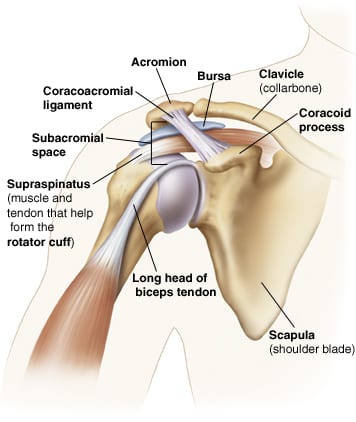The shoulder is an extremely complex part of your body. It allows for high levels of function and activities involving the arm, hand and wrist. There are a large number of moving and working parts in the shoulder which all work together to provide movement, strength, control and power. Unfortunately, especially with complex joints, there is always the possibility of pain and injury.
The anatomy of the shoulder
In its’ simplest form, the shoulder is a ball and socket joint. Firstly, the ball is the end of the upper arm bone (the humeral head). Secondly, the socket (the glenoid) is part of the shoulder blade (scapula), making up the gleno-humeral joint (GHJ). There is also a joint above the GHJ. Here, the collar bone (clavicle) meets another part of the shoulder blade (the acromium), called the acromi-clavicular joint (ACJ).
The shoulder, like all joints, has a capsule which can open up like a concertina. This allows your arm to move fully overhead. There is an extra rim of cartilage around the joint called the labrum (like in the hip joint). This provides extra stability, along with the thickenings within the capsule, which act like ligaments.
The rotator cuff is an extremely important part of the shoulder. This group of four muscles all work together. They provide stability to the shoulder joint, allowing a huge range of movement but with great control. These muscles individually are called supraspinatus, infraspinatus, subscapularis and teres minor. The larger, more powerful muscles include the deltoids, trapezius, biceps, triceps, pectorals and latissimus dorsi.
How common is shoulder pain and injury?
Pain and symptoms affecting the shoulder are reported to be the third most common musculoskeletal problem. 3% of people require medical or healthcare intervention for shoulder problems each year. According to reports, up to 70% of adults will experience shoulder pain in their lifetime.
What are the most common shoulder injuries and conditions?
- Rotator cuff strains and tendinopathies. As with any working muscle/group of muscles, there is always the opportunity to overload/overwork it and potentially injure it. At the milder end of the scale would be a rotator cuff strain. Persistent overload can lead to rotator cuff tendinopathy which can be very sore and take some time to improve.
- Rotator cuff tears. Tears can be acute and follow some trauma. They can also happen over a very long period of time, sometimes without you even knowing. In the younger population, a rotator cuff tear is usually treated with surgery (rotator cuff repair). It can take at least 6 months to fully recover from.
- Shoulder instability. This can be down to the supporting structures around the joint being damaged, usually following shoulder dislocation. It can also be related to your anatomy and the way you have developed, especially if you have done sports like swimming and gymnastics as these sports require significant ranges of motion.
- Shoulder impingement/sub acromial pain syndrome. These terms are used to describe shoulder pain that arises when you lift your arm overhead. The initial thought process was that structures above the humeral head were getting trapped/pinching as you lift the arm. Hence it was called impingement. But the truth is, this is supposed to happen. The pain could actually be coming from a number of different structures. As a result, it now tends to be called sub acromial pain.
- Frozen shoulder/adhesive capsulitis. This a condition that affects the capsule around the joint. It stiffens and contracts, which limits shoulder movement and can therefore be extremely painful.
The team at Bridge Health & Wellbeing have extensive knowledge and experience treating all shoulder conditions and injuries.
To speak to physiotherapist Paul or book a physiotherapy consultation at their health and wellness centre on Bridge Street in Christchurch, Dorset, please contact them on 01202 473800 or email info@bridgehw.com.
